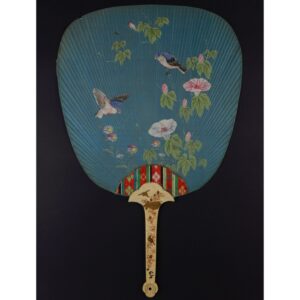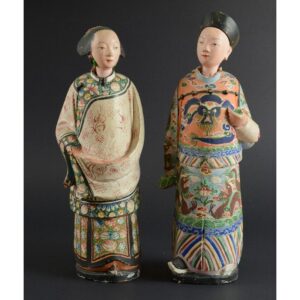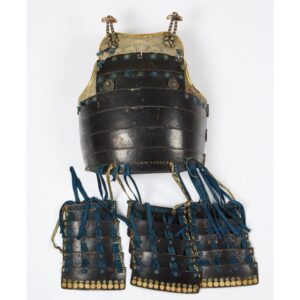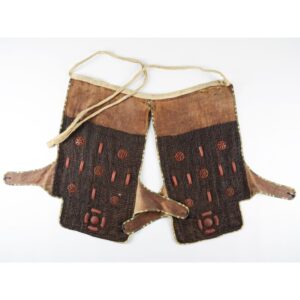Chest armour dō
Chest armour dō 胴 of the okegawa 桶側 or okegawadō 桶側胴 type, consisting of a chest and back section joined at the sides by a hinge. On both halves, the lamellae run horizontally and are riveted together, with silk straps attaching each part to the base, allowing for greater mobility. Under the shoulder straps (watagami 肩上) that rested on the warrior’s shoulders, part of the padding (manchira 満智羅), is preserved, which continues into the shoulder guard, into which small pentagonal protective plates were sewn between the textiles, preventing a hostile blade from penetrating the vital parts of the body. Most of the armour is lacquered with a dark urushi lacquer, with the lateral edges of the metal plates standing out, highlighted by a thickened rim (made of a special compound whose binder was urushi lacquer) applied directly to the metal during the manufacturing phase, and finally gilded. As an aesthetic ... more
Chest armour dō 胴 of the okegawa 桶側 or okegawadō 桶側胴 type, consisting of a chest and back section joined at the sides by a hinge. On both halves, the lamellae run horizontally and are riveted together, with silk straps attaching each part to the base, allowing for greater mobility. Under the shoulder straps (watagami 肩上) that rested on the warrior’s shoulders, part of the padding (manchira 満智羅), is preserved, which continues into the shoulder guard, into which small pentagonal protective plates were sewn between the textiles, preventing a hostile blade from penetrating the vital parts of the body. Most of the armour is lacquered with a dark urushi lacquer, with the lateral edges of the metal plates standing out, highlighted by a thickened rim (made of a special compound whose binder was urushi lacquer) applied directly to the metal during the manufacturing phase, and finally gilded. As an aesthetic addition, on the upper part of the armour, instead of lacquer, thin leather printed with a coloured stencil pattern is applied directly to the metal. Seven trapezoidal sets of lacquered metal lamellae are attached to the lower edge with silk ribbons to protect the body underneath the belt. The somewhat distinctive accessories suggest the breastplate must have belonged to a warrior of the lower or middle class. Before donning the breastplate, the samurai was required to don an arm and palm guard (kote 籠手), a skirt with chain or tiles below the waist that reached to the knees (haidate 佩楯), and a shin guard (suneate 臑当). The additional protection of the head and face depended mainly on the status of the warrior. The armour of the light infantry ashigaru 足軽 had a special metal holder on the back for attaching a bamboo pole, on which there was a heraldic sign used to identify and coordinate units on the battlefield. Horizontal holes can be seen on the lower part of the rear half of the armour, where the lower part of the flag holder was located, while the upper part is missing. (BŠ)

















































Do you have a comment or additional information about the subject?